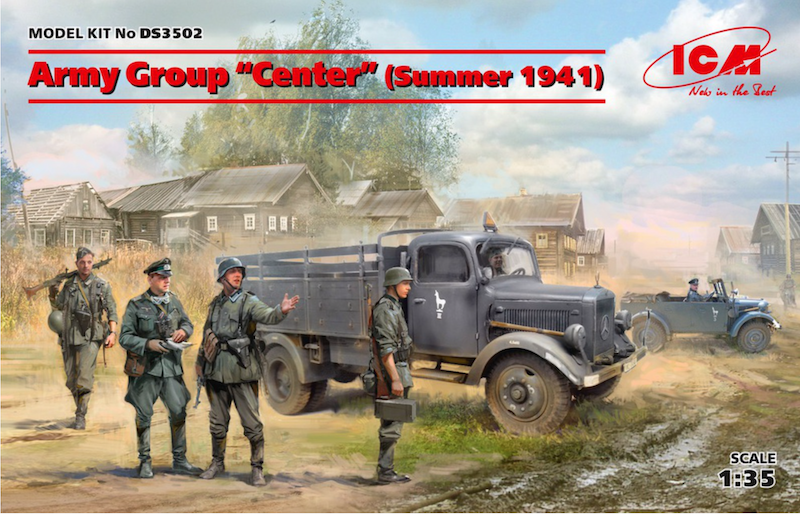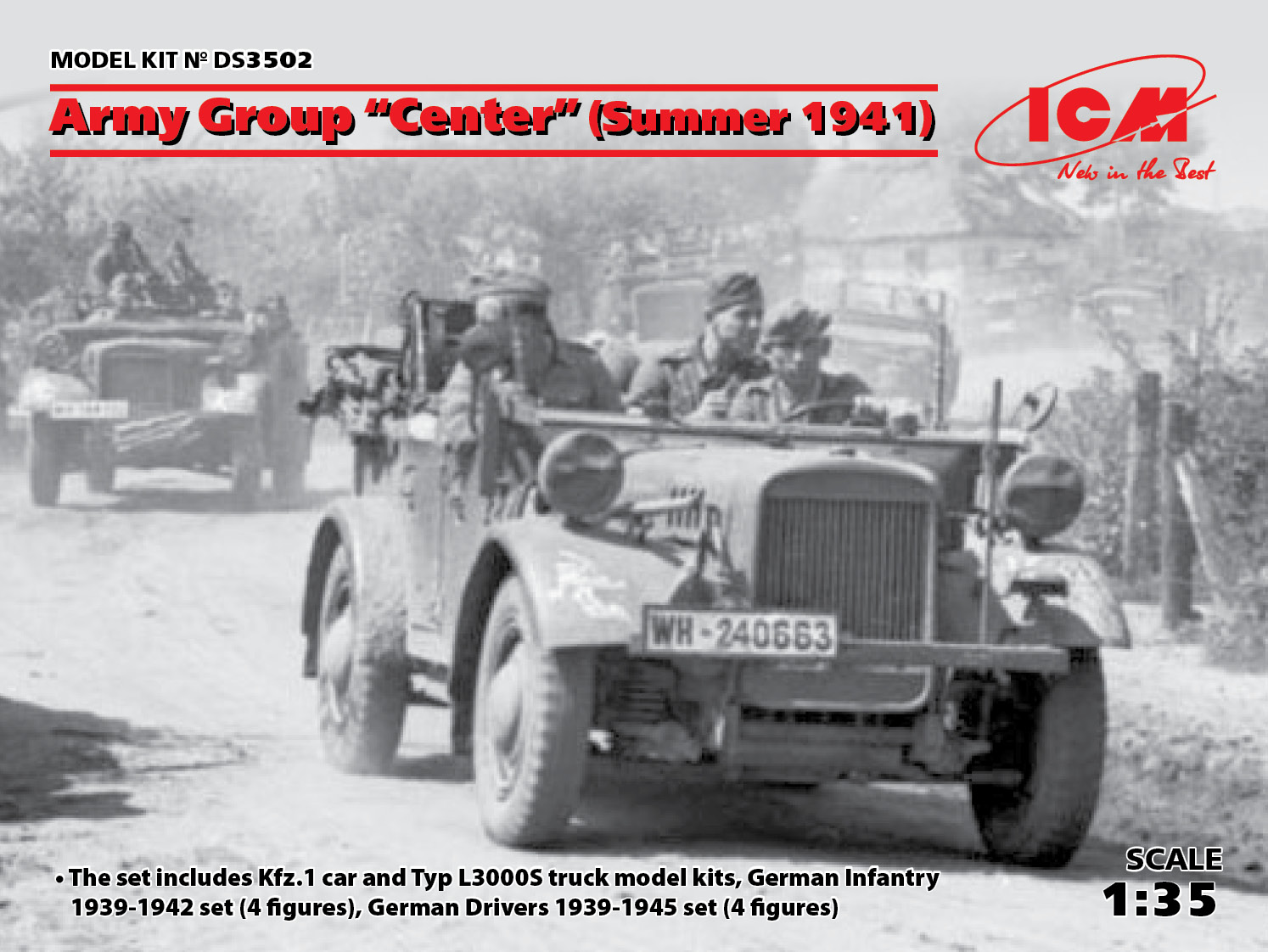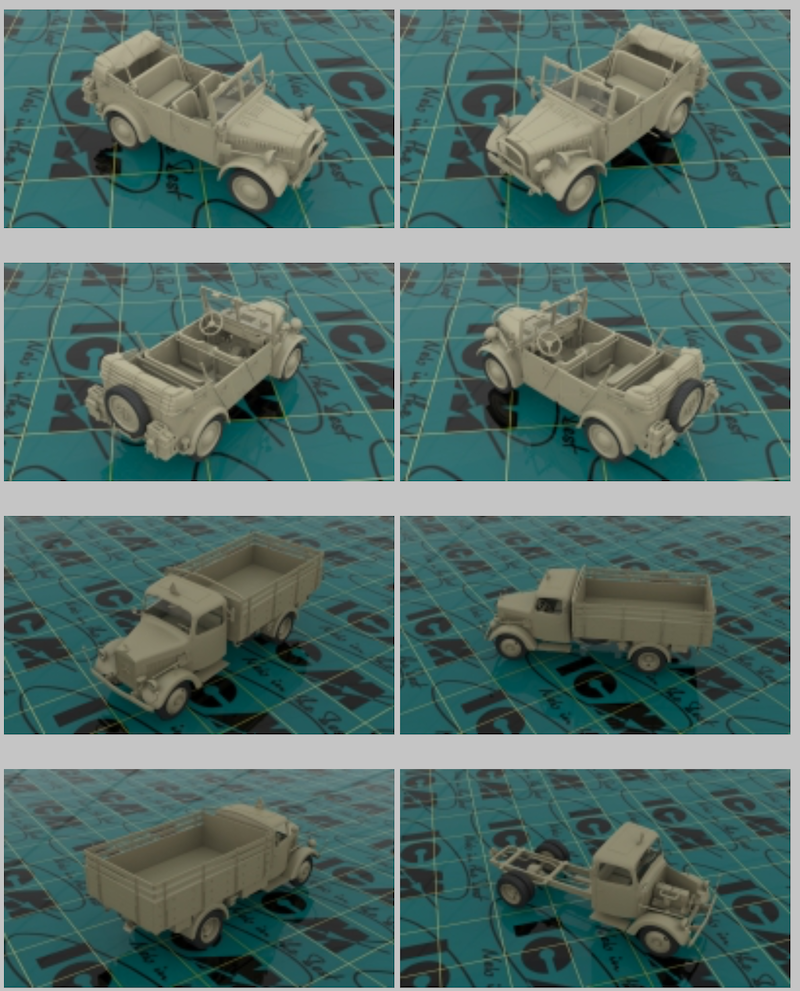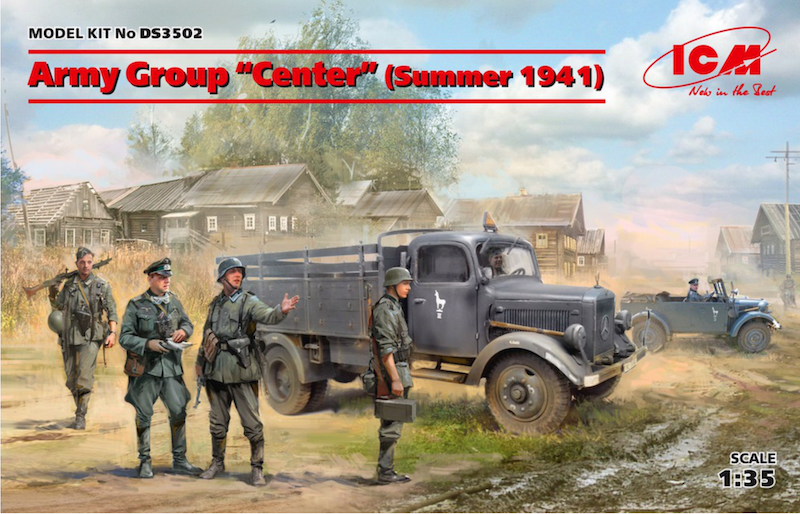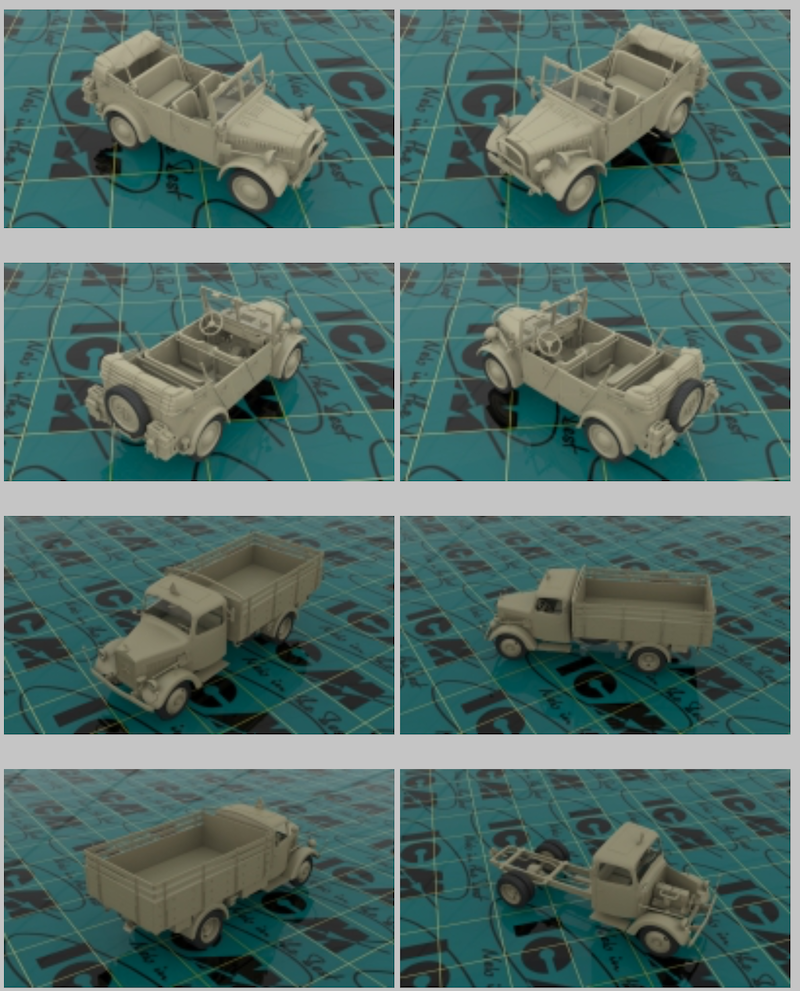ICM ICMDS3502
- Description:
- Army Group "Center" (Summer 1941) (Kfz.1, Typ L3000S, German Infantry (4 figures), German Drivers (4 figures) Diorama Set
- Manufacturer:
- ICM
- Code Number:
- ICMDS3502
- Scale:
- 1:35
- Item type:
- Military vehicle kits (injection)
- Price:
- £59.80
- Order Quantity:
- Quantity In Stock:
 5+
5+
- Availability:
- This will usually be dispatched within 24/48 hours of receiving your order
- Wish List:
- Department:
- Catalogue
Here are some books and decals you might find useful for this kit
Found 4 related products
Deprecated: substr(): Passing null to parameter #1 ($string) of type string is deprecated in /mnt/vault/Sync/Dessol/Sites/hannants.co.uk/htdocs/product.inc.html on line 911 | Star Decals - 35-C1406 - 1:35 | BATUS # 1. British Army Training Unit Suffield in Canada. Ferret Scout Car Mk.2 Mk.1/2 and Mk.2/3. Range Safety Control Group. More | Military vehicle decals | New Arrivals | £10.20 | |
 | Linden Hill - LHD35002 - 1:35 | Bush War Hinds 2 - Mil Mi-24s' This package comes with a four colour loose-leaf reference booklet featuring profiles and photographs. Mil Mi-24RKh Red 41, Group of Soviet Forces in Germany, 1991 Mil Mi-24V 0813, Slovak Air Force Mil Mi-24V JSO `Red Berets', Serbia, 1998 Mil Mi-24VP Red 33, Naval Aviation of the Baltic Fleet of Russia Mil Mi-24D CH612, Sri Lankan Air Force, 1997 Mil Mi-35 H-357, ngolan Air Force, 1991 Mil Mi-35, Eritrean Air Force, 2000 Mil Mi-35, Ethiopian Air Force, 2000 Mil Mi-25 4493, Iraqi Army Aviation Corps, 1991 Mil Mi-24D TU-VHO, National Armed Forces of the Ivory Coast, 2002 Mil Mi-35, Z3039, Indian Air Force [Mil Mi-24V Hind-E Helicopter] More | Aircraft decals (military) | Catalogue | £16.99 | |
Deprecated: substr(): Passing null to parameter #1 ($string) of type string is deprecated in /mnt/vault/Sync/Dessol/Sites/hannants.co.uk/htdocs/product.inc.html on line 911 | MA Publications - MAE07 - No Scale | Building the Republic P-47D Thunderbolt. The Republic P-47 Thunderbolt Big, powerful, and truly a juggernaut of an aircraft, resulting in its appropriate nickname 'Jug', the Republic P-47 Thunderbolt was one of the really great warplanes of its generation. Alongside the superlative North-American P-51 Mustang and the twin-engined Lockheed P-38 Lightning, it was one of the three principal fighter types which the US Army Air Forces (USAAF) successfully operated in the later stages of World War Two. The initial production version was the P-47B, and examples of this type started to reach the USAAF's 56th Fighter Group in June 1942. The first really combat-ready model was the refined and slightly longer P-47C, which entered service later in 1942. Like all front-line P-47 versions it packed a formidable punch of four 0.5in M2 Browning machine guns in each wing, although early models did not carry the wing pylons that became so important later in the Thunderbolt's combat career. The first P-47C examples to reach Britain for the US Eighth Army Air Force did so in December 1942, followed by what became the main combat model of the Thunderbolt, the P-47D, in April 1943. Weighing in at some 15,000lb (6,804kg) fully loaded and powered by the R-2800-59 Double Wasp of 2,000hp, the P-47D was a big, powerful beast. Water injection introduced for some versions of the R-2800 would see even greater power on demand when needed in aerial combat. All of these early Thunderbolts had the 'razorback' high line rear fuselage pioneered with the P-35 and P-43, with a rearwards-sliding heavily framed cockpit canopy. Although the USAAF at first saw the Thunderbolt as a high altitude interceptor, its main initial role very soon became that of daylight bomber escort with the England- based Eighth Air Force, which was in great need of escort fighters for its B-17 Flying Fortresses and B-24 Liberators that were increasingly facing stiff Luftwaffe fighter opposition. he Thunderbolt helped to turn the tide for the US daylight bombing offensive during 1943 and early 1944, with a number of P-47 pilots gaining impressive scores in air-to-air combat against Luftwaffe fighters. Eventually the appearance of the Merlin-engined P-51B Mustang and later versions of the superb Mustang long-range fighter resulted in the Eighth Air Force almost completely re-equipping its fighter groups with the P-51, but the Eighth's 56th Fighter Group continued to fly the Thunderbolt right up to the end of the war in Europe in May 1945. The Eighth Air Force also pioneered the P-47 for air-to-ground operations as a part of its policy of taking the fight to the Luftwaffe, and additional to this the Thunderbolt eventually equipped several fighter groups specifically for fighter-bomber operations within the tactical England-based US Ninth Air Force. The P-47 proved to be a formidable fighter-bomber due to its impressive eight-gun armament, bomb load and ability to survive enemy fire. The underwing pylons that proved so useful for long-range fuel tanks were equally at home carrying a 500lb (227kg) bomb (one under each wing), and the Ninth Air Force in particular used this capability to devastating effect against German tactical targets before and after D-Day. 'Razorback' Thunderbolts additionally equipped USAAF units in Italy, the Pacific (including exceptional use by the Fifth Air Force), and the China-Burma-India theatre (CBI). Continuing development of the P-47 design led to the adoption later in P-47D manufacture of a cut- down rear fuselage spine and all-round vision 'bubbletop' canopy. This resulted in a further series of later Thunderbolt versions with even greater range and capabilities, but many 'razorback' P-47s nevertheless continued in service right to the war's end " some pilots in fact preferring the 'razorback' to the later models particularly for their better directional stability. Other important users of the Thunderbolt in World War Two included the Soviet Union, the RAF and the Free French. This seventh book in the highly successful MA Extra Series contains fourteen showcase and step by step model builds and will be a must for any P-47 aficionado! More | Aircraft books | Catalogue | £14.99 | |
Deprecated: substr(): Passing null to parameter #1 ($string) of type string is deprecated in /mnt/vault/Sync/Dessol/Sites/hannants.co.uk/htdocs/product.inc.html on line 911 | Naval Fighters - NFAF223 - No Scale | Douglas C-74 Globemaster By Nicholas M. Williams, 104 pages (88 in b&w, 16 in color), 141 b&w photos, 35 color photos, 22 illustrations. The Japanese attack on Pearl Harbor in December 1941 brought U.S. Army Air Corps strategists to the realization that a new global transport was needed to carry large loads over great distances. The Douglas Aircraft Company in Santa Monica, California, also quickly saw this need and design studies were begun immediately on an expanded version of the company's DC-4. The "C-74 Project Group" adopted a design philosophy to produce a "no frills" transport able to accommodate at least two of the Army's T-9 tanks, two 105mm Howitzers, or two angle dozers. Douglas contacted the Air Corps early in 1942 to determine their interest and a letter of intent was issued in March 1942 for procurement of the Model 415A, now designated the C-74. A contract of over $50 million was signed in June 1942 for fifty airplanes. To speed its delivery to operational units, the C-74 was designed to be released without the benefits of an experimental or prototype model, all aircraft being designated as C-74s with design features following conventional "state-of-the-art" practice. Originally, powered by Wright R-3350 engines, a decision was made in March 1943 to switch to the new, mammoth Pratt & Whitney R-4360 Wasp Major. The first C-74 was rolled out in July 1945 from the Douglas Long Beach factory. At rollout, the C-74 was the largest land-based transport in the world with a wingspan of 173 feet, length of 124 feet, and gross weight of 145,000 pounds. Able to carry 125 passengers, the C-74 was called the Globemaster as its 11,100-gallons of internal fuel gave it a maximum range of over 7,000 miles, enabling it to circumnavigate the world with only two refueling stops. In its final form, the C-74 was a remarkably efficient airplane, using a semi-laminar flow airfoil for its wings with a full-span flap arrangement. The pilots were enclosed by two teardrop-shaped, double-bubble canopies that provided them with a 360-degree view. Douglas had every intention of adapting the C-74 into a civil airliner once hostilities had ended. In 1944 Pan American World Airways ordered 26 examples of the civil version, the DC-7, for a route expansion program into Latin America. However, further development of this DC-7 design increased its gross weight to 162,000 pounds and the unit cost to $1.4 million and Pan American cancelled its order in October 1945, opting for smaller transports. The first C-74, 42-65402, made its maiden flight from Long Beach in September 1945, but with the end of World War II, most of the C-74 production order was cancelled and only 14 Globemasters were built. Unfortunately, during contractor demonstration flights the second Globemaster crashed. The fourth C-74 was subsequently diverted for static tests and its components tested to destruction at Wright Field, Ohio. Beginning in September 1946, the remaining twelve C-74s were flown for the next nine years by the Army Air Forces' Air Transport Command and the U.S. Air Force's Military Air Transport Service. Once in service, the C-74 Globemaster, based first in Memphis, Tennessee, then Morrison Field, West Palm Beach, Florida, finally at Brookley AFB, Mobile, Alabama, set many records for tonnage carried. In November 1949, a C-74 flew the Atlantic to England with a record 103 passengers aboard. One Globemaster set several records during the Berlin Airlift, averaging over 38,000 pounds of cargo and setting a new Airlift Task Force utilization record by flying 20 hours in a 24-hour period. Until one C-74 was converted to the prototype C-124A and the Globemaster II became available, the C-74 was the only Air Force transport capable of carrying outsized cargo. After the C-74's retirement from service in 1955, several were purchased surplus and began flying for a contract air carrier, Aeronaves de Panama, hauling prize cattle from Denmark to the Middle East, horses to Singapore, and ships' parts and vegetables throughout Europe. Unfortunately, after the tragic crash in 1963 of one C-74 in Marseilles, France, the airline suspended operations and its C-74s eventually were scrapped. Today, no examples of this record-setting transport exist. This monograph of the C-74 Globemaster is written by Nick Williams, an award-winning author of over two dozen articles published in the Journal of the American Aviation Historical Society and publications in the U.K. Nick has written two previous books in Steve Ginter's Naval Fighters series as well as his 1999 book published in the U.K., "Aircraft of The Military Air Transport Service 1948-1966". His new book on the C-74 is the result of nearly fifty years of research, containing comments from several of the C-74's engineers as well as former Douglas and Air Force pilots. More | Aircraft books | Catalogue | £27.40 |
Hannants Search Engine
Convert Currency
Copyright © 2001-2025 H. G. Hannant Limited. All rights reserved. | Website by Dessol
Privacy Policy | Cookie Information | Switch to Mobile Version




